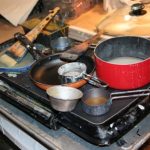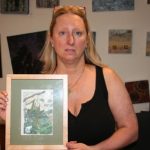Catherine Weber working with wax
By Jane Keller Gordon, Contributing Writer
Southborough – Southborough artist Catherine Weber is fascinated by encaustic painting, also known as hot wax painting, in which pigments are added to heated beeswax and painted on a surface.
“There’s every sense — the smell of the wax is wonderful, the luminosity, the flexibility – all of these things make encaustic wonderfully flexible,” she said. “This art is several thousands of years old. It’s been found on Egyptian sarcophagi, and on the hulls of Greek ships.”
With a pancake griddle, electric skillet, Hake art brushes, and an assortment of measuring cups, frying pans and loaf pans, Weber creates her art in a studio behind her home. She lives with her husband Paul and 15-year-old son in a 125-year-old Victorian farmhouse, shaded by a huge copper beech tree that might be as old.
Weber grew up on a farm in upstate New York, then in Indiana, and for the longest time in Clinton, Conn., moving with her father’s job as a plastics engineer. Her mother, an elementary art teacher, passed on to Weber her talent and joy of art.
“I took classes I everything, from oils to drawing to charcoal pottery to jewelry making,” Weber said.
In addition to talent, Weber inherited her mother’s entrepreneurial spirit. She sold macramé hanging plant holders when she was 10. She honed her business sense at Emerson College, where she majored in communication studies and earned a master’s degree in critical and creative thinking from UMass Boston.
She ran her own digital marketing firm for 18 years, and now works remotely marketing an online training program.
Weber’s husband Paul also grew up in Clinton, Conn. They started dating when they were 17 and moved to Southborough in 1997.
Along with art, poetry is one of Weber’s passions. In 2007, she won an award in Worcester Magazine’s poetry contest for her poem, “Still Life Without Pear.”
Weber’s initial focus on art was acrylic collage. She shifted to encaustic painting back in 2007 or 2008.
“There has been a revival of encaustic painting in the last 15 years,” Weber explained.
Starting with a cradled birch-painting panel, which does not warp when heat is applied, Weber coats the surface with an encaustic gesso primer. This creates a porous surface that will absorb and fuse with the wax. Weber tapes the edges of her panel with blue tape to keep them clean. She uses purchased wax, and she creates a clear encaustic medium with beeswax and Damar resin, which she pours into molds, such as an ice cube tray. Weber uses pigment powders or purchased color wax to add color.
Weber likes to experiment and incorporates photographs, wood, and other media.
“The wax cools quickly so I can work with it,” she noted.
She has created a series called Contemporary Mosaics in Wax, for which she created tiles from wax.
She also teaches and has done demonstrations at a number of art guilds.
Weber’s encaustic pieces are currently available at Heart and Stone Jewelry in Northborough, and as part of the “Vision and Verse” exhibit at the University of New England in Portland. They can also be viewed on her website, www.catherinemweber.com.
Photos/Jane Keller Gordon














